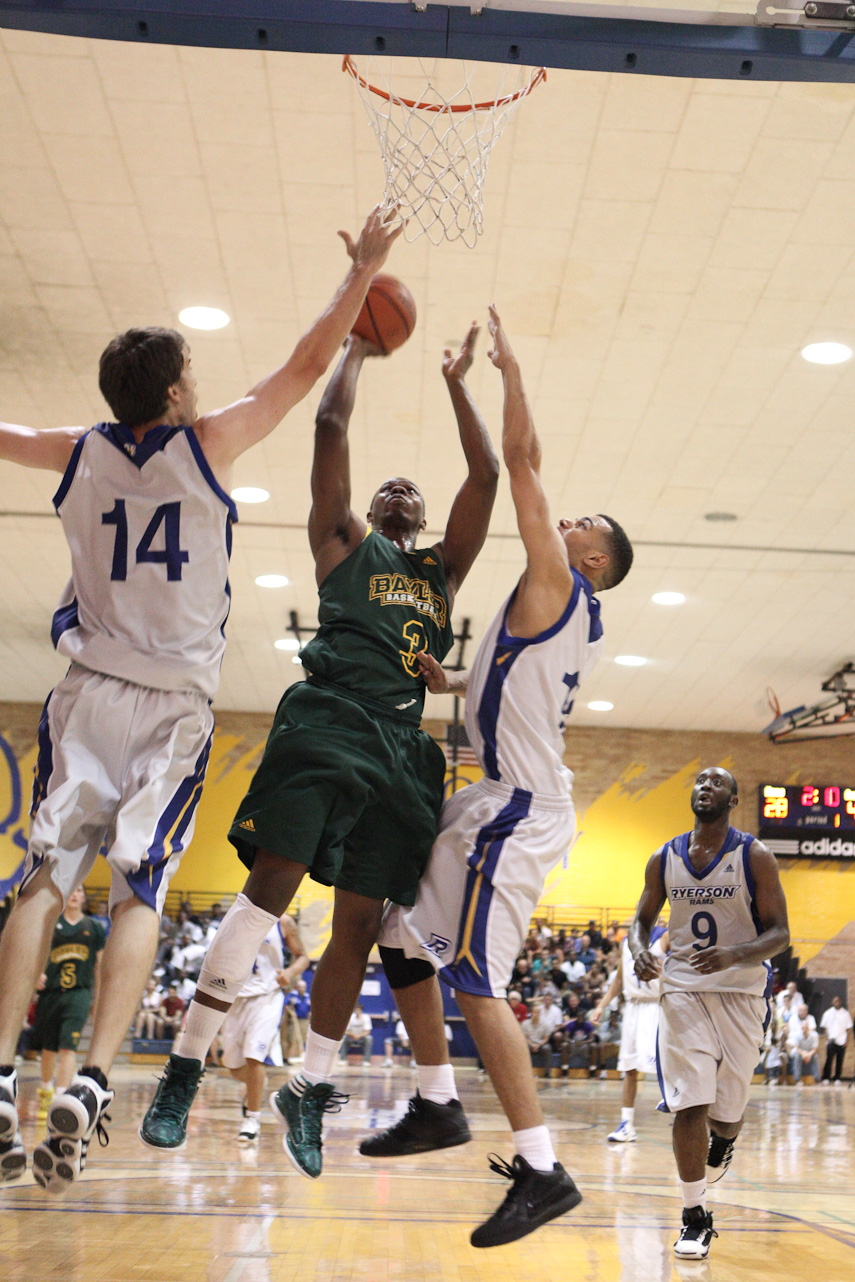By: Victor Ferreira
The members of Ryerson’s men’s basketball team were hoping that they could prove themselves against future NBA stars. by inviting the Baylor Bears to play at Kerr Hall Gym on Aug. 13.
While the teams played competitively throughout the course of the match. it also made it abundantly clear that there is an astronomical difference in regards to the talent level in Canadian Interuniversity Sports (CIS) and in the National Collegiate Athletic Association (NCAA).
The NCAA players, as Baylor displayed, are not simply more talented, but are taller, stronger, faster and more athletic than their Canadian counterparts.
When asked if the current Rams team would be able to survive in the Bears’ Big 12 conference, Baylor head coach Scott Drew smiled and the thought.
“I’ll let you think about that one,” he said.
While there are Several reasons to explain why such a gap in skill has formed between the two organizations, the first and most apparent reason for this gap in talent is and always will be the money.
The majority of the athletes playing on NCAA teams, such as Baylor, have received fully paid athletic scholarships to the university. In the coming school year, tuition and residence at Baylor University will exceed $38,000, a price that many student-athletes could not afford on their own.
The schools that play in the CIS simply do not have the type of funding to be able to put a student athlete through school for one year, let alone for four. The academic scholarships offered by Ryerson Athletics range from a minimum of $500 to a maximum of $3,500, while Ryerson University’s tuition costs range from a minimum of $6,074.70 to a maximum of $8,488.38. This means that in a best-case scenario, Ryerson athletes would have little more than 50 per cent of their tuition awarded through scholarships.
“Full scholarships really make the difference in attracting better quality players. You’re supposed to be more talented than the teams in the CIS,” said Drew.
Scholarships aside, some basketball players simply don’t want to play their game in Canada as collegiate sport in America is nationally televised and is considered to be a multi-billion dollar business.
In recent years, basketball in Canada has never been successful and a majority of those who have played in this country did not have the skills necessary to progress to the NBA. This is why only a select few Canadians play in the NBA, with Phoenix Suns guard and former two-time MVP Steve Nash.
Rams guard Jordan Gauthier attributed this stereotype as a major reason in explaining why several players prefer to play in the United States.
“There is a difference because Canadian basketball has a negative stereotype [attached to it],” said Gauthier. “[But] if you took [Ryerson’s] team and put it in the Big 12, it wouldn’t be fair.”
Currently, Canada’s men’s senior basketball team is ranked 23 in the International Basketball Federation’s (FIBA) world rankings, being placed below struggling sporting nations such as Iran, Nigeria, and Venezuela.
However, the United States is ranked as the world’s number one basketball teams, reaffirming that the best basketball players in the world are American and have been able to succeed because of the many years they’ve spent playing the game at the highest level in the world.
With the United States having such a good reputation for developing basketball superstars and Canada having such a poor one, it is no wonder that not many players wish to ply their trade in the CIS.
But, no matter how bleak the present looks, Gauthier looks towards an optimistic future for basketball in Canada.
“Things are changing. We have a lot of athleticism. Canadian basketball is becoming more competitive and the players are becoming bigger and stronger.”
Gauthier’s hope for the future is shared by Canadian Baylor guard Brady Heslip who looks to have a bright future with the Bears which could lead him to an NBA career.
“Canadian basketball is still growing,” said Heslip. “A few years back, there were only a select number of guys playing [in the NCAA], now there are around 10-12 a year. One day they’ll be able to compete.”
Whether Gauthier’s bright outlook for Canadian basketball will ever lead the CIS to compete with the NCAA in terms of talent remains to be seen. To continue to close the gap, Canadian universities must take their athletics more seriously so that they can attract higher level athletes and begin to eat away at Canada’s negative reputation as a poor sporting nation.










Leave a Reply